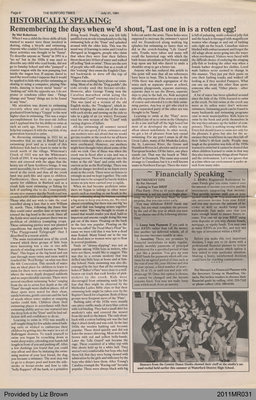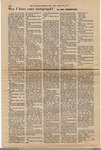HISTORICALLY SPEAKING:
Remembering the days when we'd shout, "Last one in is a rotten egg!
By Mel Robertson
When I was a child the three skills all kids wanted to master were those involved in skating, riding a bicycle and swimming. Anyone who couldn't become proficient in these activities was thought to be "funny". To describe anyone as "funny" in 1991 is a "no no" but in the 1920s it was used to describe any child who read books, did not go to Sunday School and who "pumped" a coaster wagon with the non-pumping foot inside the wagon box. If anyone dared to used the word today I suppose that it would be applied to kids who prefer swimming or skating to using a computer, playing Nintendo, dancing to heavy metal "music" or "making out" with the opposite sex. I do not praise or condemn either time - Things change and "funny" things are to be found in any "time".
My attention was drawn to swimming recently when one of my grandsons graduated from being a "Guppy" to the next higher class in swimming. This was a major accomplishment for five-year-old Jeffrey and I applaud him for his ability to swim at such an early age. However, I could not help but compare it with the way kids of my generation learned to swim.
In discussing swimming in 1922 let us remember that no one in Burford had a swimming pool and as a result of this deficiency kids had to learn to swim in the creek north of the village. Whiteman's Creek of 1922 was not the Whiteman's Creek of 1991. It was larger and the stones were not covered with the algae that the heavy use of farm fertilizers brings. It was more accessible, for in 1922 cattle were pastured at the creek and thus all the creek land was park-like and open to children. Furthermore, there were no organized sports for children in Burford and as a result kids went swimming or fishing for lack of anything else to do. Consequently, on any nice summer day the North road was crowded with children walking to the creek. Those who did not wish to take the road travelled along a lane that is now William St. north. Then, following the fence line they could enter another lane or turn west toward the big bend in the creek. Since all the fields were used as pasture there was no problem of children trampling crops. These swimming parties were not planned expeditions but merely kids gathered by "The Playground Telegraph" that I described in a recent article.
The main recreational area of the creek toward which these groups of little boys were hastening was a one or two mile stretch of winding creek known as "Bakers Flats". This began at the big bend and ran east through many twists and turns until it reached the "Red Bridge" on what was then the 6th Concession. This stretch of water was an ideal place for children to learn to swim for there were no treacherous places where the water depth dropped suddenly and no unpredictable currents. There were several excellent swimming "holes" ranging from the six to seven feet depth at the old "Dam" through more shallow places. All of these spots were noted for their clean, sandy bottoms, gentle currents and the lack of weeds where water snakes or snapping turtles could hide. Children chose their swimming places in accordance with their swimming ability and no one ventured into the deep hole at the "Dam" until he had sufficient skill and confidence to do so.
Learning to swim in 1922 was usually a self-taught thing for few adults owned bathing suits or wished to embarrass their children by getting into the water in a set of Balbriggan drawers. To teach yourself to swim you began by crouching down in waist-deep water, extending your hands full length in front of you and pushing off. After a few dunkings you found that you could stay afloat and then by imitating the swimming motion of your best friend, the dog, you became a swimmer. The next step was to go to a deeper pool and learn the side-stroke or breast-stroke and how to take "belly Hoppers" off the bank, or a primitive
diving board. Finally, when you felt fully qualified you strode triumphantly to the big swimming hole at the "Dam" and splashed around with the older kids. This was the usual way of learning to swim and I tend to disregard as braggarts, people who claim that when they were four their fathers threw them into 10 feet of water and walked off yelling "Sink or swim". These are the sort of people who will claim that as a result of this "training" they swam the English Channel backwards or dove off the top of Niagara Falls.
There was nothing fancy about our swimming. Most of us did the "Dog paddle", the side-stroke and the breast-stroke. However, after George Young won the Catalina marathon swim using the "Australian Crawl" everyone tried to do it. This was (and is) a version of the old English stroke, the "Trudgeon", which involved bringing the arms out of the water with each stroke and turning on the side to take in a gulp of air (or water). Everyone tried his own version of the "Crawl" with varying degrees of failure.
All-day swimming all summer turned most of us into good, if slow, swimmers and our mothers were not afraid that we would get into trouble at the creek for we all knew never to swim right after a meal or when we were overheated. However, our mothers might have thought twice about some of the risks we took. One of these was when the creek was in flood after a rain and was a roaring torrent. Then we would get into the water at the old "dam" and swim with the current as far as the Red bridge. There was really no danger involved as we knew every stone in the creek. There were no fences to entangle us and we kept together. The only hazard was to be scraped by barely-hidden stones as you were carried over a rapids.
When we had become proficient swimmers we began to indulge in other water sports such as standing on our heads in the water, swimming along tbf b
a big stone to keep you down, etc. We tried almost everything but there was one big "no no" and that was banging stones together under water. This was thought to create a sound that would render you deaf, bald or impotent and anyone caught doing this was put out of the water. Floating on the back or the face was popular. Floating on the face was called "the Dead Man's Float" because we were told that it was how a dead man floated. Many found out in the war that dead men or women were apt to float in several positions.
Nude or "skinny-dipping" was not as popular among 1920s boys as writers, who were not there, would like to suggest. This was due to a certain modesty that was drilled into little boys at home and at Sunday School. Nude swimming was also discouraged by the fact that all the swimming holes of "Baker's Flats" were close to a well-beaten car track that took hordes of pick-nickers to the creek. Kids were discouraged from swimming nude by the fear that they might be observed by the Methodist Ladies Bible class or that their swimming hole might be taken over by the Baptist Church for a baptism. Both of these groups were frequent users of the "Flats".
Bathing suits of the 1920s were usually one-piece outfits made of navy blue cotton with red binding. They had a small skirt for modesty's sake and covered the wearer from the neck to the knees. The only drawback with a cotton bathing suit was the fact that it dried slowly and was cold. In the late 1920s the woolen bathing suit became popular. These dried quickly and did not leave the wearer shivering. Most were dark brown with red and yellow belly-bands. Later the "Life Guard" suit became the rage. These consisted of a white top with blue shorts held up by a white belt. They weren't very comfortable but boys who had them felt that they were being viewed with admiration by the girls and with envy by the boys who didn't have them. After Young's Catalina triumph the "Racing suit" became popular. These were always black with big
holes cut under the arms. These holes were supposed to increase the swimmer's speed and we floundered along making big splashes but swimming no faster than we did in the crotch-binding "Life Guard" suits. Trunks were taboo and many will recall the hysterical rage with which the bath-house attendants at Port Dover would leap upon any kid who dared to undo a shoulder strap to get a better tan.
Anyone who has endured this article to ! this point will note that all my references I have been to boys. This is because in the 11920s there was much segregation of the ' sexes such as separate doors at school, separate playgrounds, separate stairways, separate days to use the library, separate days to play in the hall, etc. Kids accepted this silly separation of the sexes as a matter of course and extended it to the little swimming parties. Any boy or girl who tried to join a separated party of the other sex was thought to be "funny".
Learning to swim at the "Flats" never qualified any of us to swim in the Olympics or do a one and half off the high board but most of us developed the ability to stay afloat almost indefinitely. In other words, we got a lot of pleasure from lazy casual swimming. For my part I swam in all the Great Lakes, many of the Muskoka Lakes, the St. Lawrence River, the Goose and Hamilton Rivers in Labrador and at several European beaches. Of the latter, one place stands out. That was the beach at "Mid-dlefart" in Denmark. This name may sound strange to Canadians but it is a well-known name in Northern Europe. There the water
is full of pulsating, multi-coloured jelly-fish and the beach is thronged with magnificent women who change in and out of bathing suits right on the beach. Canadian visitors blushed with embarrassment and forgot the old adage about never going into the water when overheated. Visitors were faced with the difficult choice of enduring the stinging jelly-fish or looking the other way when a female bather dropped her clothes. Local male bathers never seemed to change in this manner. They just put their pants on over their bathing trunks and walked off looking as if they needed Pampers. What can one say about this other than quote someone who said, "Other places - other faces"?
A lot of water has been splashed around since the kids of the 1920s learned to swim at the creek. No kid swims at the creek any more as its sullen water don't welcome swimmers. Swimming pools can be found in many backyards and swimming programs exist in most municipalities. Kids learn to swim by the book and pride themselves in the way they advance up the ladder of competence. There is nothing wrong with that. Every kid should learn to swim not only for the pleasure it gives but also for the assurance they would have in case they fall off their father's 60-foot yacht. People may laugh at the primitive way kids of the 1920s learned to swim but it cannot be denied that when children learned to swim in that way they also learned many things about Nature and the environment. Let's not ignore that at a time when our environment is under attack from many sides.



